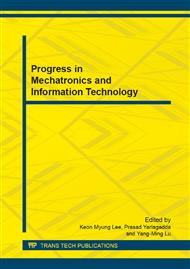[1]
Shurmer H, Fard A, J Baker, P. Bartlett, G. Dodd, U. Hayat. Development of an Electronic Nose [J]. Physics in technology, 1987, Vol. 18(4): 170-176.
DOI: 10.1088/0305-4624/18/4/i04
Google Scholar
[2]
Univ of Warwick, United Kindom. Electronic nose. A sensitive and discriminating substitute for a mammalian olfactory system [J]. IEE proceedings. Part G. Electronic circuits and systems, 1990, Vol. 137(3): 197-204, ISSN: 01437089.
DOI: 10.1049/ip-g-2.1990.0030
Google Scholar
[3]
Matthes J, Groll L, Hubert B K. Optimal weighting of networked electronic noses for the source localization [J]. Proceedings of the 2005 Systems Communications, (2005).
DOI: 10.1109/icw.2005.64
Google Scholar
[4]
Chen Liwei, Yang Jianhua. Experimental Study on Odor Source Localization System Based on Metal Oxide Gas Sensors [J]. IEEE Third International Conference on Measuring Technology Mechatronics Automation, 2011, 3(23): 143-146.
DOI: 10.1109/icmtma.2011.5767266
Google Scholar
[5]
Belanger J. H, Willis M.A. Biologically-inspired search algorithms for locating unseen odor sources [C]. Proceeding of the 1998 IEEE ISIC/CIRNISAS Joint Conference. Garthersburg: [s, n], 1998; 265-270.
DOI: 10.21236/ada402125
Google Scholar
[6]
Moriizumi T, Ishida H. Robotic systems to track chemical plumes [M]. USA: IEEE, 2002: 537-540.
Google Scholar
[7]
Rozas R, Morales J, Vega D. Artificial smell detection for robotic navigation. In: Fifth International Conference on Advanced Robotics, 1997: 1730-1733.
DOI: 10.1109/icar.1991.240354
Google Scholar
[8]
Ishida H, Nakamoto T, Moriizumi T. Fundamental study of mobile system for smelling object localization using plural gas sensor [C]. Proceedings of the 32nd SICE Annual Conference. Kanazawa: IEEE Industrial Electrics Society, 1993: 767-768.
Google Scholar
[9]
Ishida H, Suetsugu K, Nakamoto T, et al. Study of autonomous mobile sensing system for localization of odor source using gas sensors and anemometric sensors [J]. Sensors and Actuators, 1994, 45(2): 153-157.
DOI: 10.1016/0924-4247(94)00829-9
Google Scholar
[10]
Ishida H, Nakamoto T, Moriizumi T. Remote sensing and localization of gas/odor source and distribution using mobile sensing system [C]. International Conference on Solid-state Sensors and Actuators, 1997, 559-562.
DOI: 10.1109/sensor.1997.613711
Google Scholar
[11]
Nakamoto T, Ishida H, Moriizumi T. Active odor sensing system [C]. Proceeding of the IEEE International Symposium on Industrial Electronics, 1997, 128-133.
DOI: 10.1109/isie.1997.651748
Google Scholar
[12]
Ishida H, Nakamoto T, Moriizumi T. Remote sensing of gas/odor source location and concentration distribution using mobile system [J]. Sensors and Actuators, 1998, 52-57.
DOI: 10.1016/s0925-4005(98)00036-7
Google Scholar
[13]
Ishida H, Kobayashi A, Nakamoto T, et al. Three-dimensional odor compass. IEEE Transactions on Robotics and Aytomation, 1999, 15(2): 251-257.
DOI: 10.1109/70.760346
Google Scholar
[14]
Ishida H, Yoshikawa K, Moriizumi T. Three-Dimensional Gas-Plume Tracking Using Gas Sensors and Ultrasonic Anemometer [C]. Proceedings of the IEEE Sensors 2004, 1175-1178.
DOI: 10.1109/icsens.2004.1426387
Google Scholar
[15]
Ishida H, Tanaka H, Taniguchi H, et al. Mobile robot navigation using vision and olfaction to search for a gas/odor source [J]. Autonomous Robots, 2006, Vol. 20(3): 231-238.
DOI: 10.1007/s10514-006-7100-5
Google Scholar
[16]
Ishida H, Kohnotoh A. Active stereo olfactory sensing system for localization of gas/odor source [C]. Proceedings-7th International Conference on Machine Learning and Applications, 2008, 476-481.
DOI: 10.1109/icmla.2008.101
Google Scholar
[17]
Ohashi M, Enomoto S, Ishida H. Actively generated flow field helps a crayfish robot collect chemical signals [J]. ECS Transactions, 2009, Vol. 19 (6): 337-341.
DOI: 10.1149/1.3118570
Google Scholar
[18]
Russell R A. Odor sensing robot draws inspiration from the insect world [C]. Proceedings of the IEEE International Conference on Bioelectromagnetism, 1998: 49-50.
DOI: 10.1109/icbem.1998.666389
Google Scholar
[19]
Russell R A. Ant trails-an example for robots to follow? [C]. Proceedings of the IEEE International Conference on Robotics and Automation, 1999: 2698-2703.
DOI: 10.1109/robot.1999.774005
Google Scholar
[20]
Russell R A. Chemical Source Location and the RoboMole Project [C]. Australasian Conference on Roboticsand Automation, (2003).
Google Scholar
[21]
Hayes A T, Martinoli A, Goodman R M. Swarm robotic odor localization [C]. Proceedings of the IEEE/RSJ International Conference on Intelligent Robots and Systems, 2001: 1073-1078.
DOI: 10.1109/iros.2001.976311
Google Scholar
[22]
Hayes A T, Martinoli A, Goodman R M. Distributed odor source localization [J]. IEEE Sensors Journal, 2002, Vol. 2(3): 260-271.
DOI: 10.1109/jsen.2002.800682
Google Scholar
[23]
Lilienthal A, Duckett T. Creating gas concentration gridmaps with a mobile robot [C]. IEEE International Conference on Intelligent Robots and Systems, 2003: 118-123.
DOI: 10.1109/iros.2003.1250615
Google Scholar
[24]
Lilienthal A, Duckett T. Experimental Analysis of Smelling Braitenberg Vehicles. In: Proceedings of the IEEE International Conference on Advanced Robotics (ICAR 2003). Coimbra, Portugal, 2003: 39-43.
Google Scholar
[25]
Lilienthal A, Duckett T. Building gas concentration gridmaps with a mobile robot [J]. Robotics and Autonomous Systems, 2004, Vol. 48(1): 3-16.
DOI: 10.1016/j.robot.2004.05.002
Google Scholar
[26]
Amy L, Mathias B, Silvia C, et al. Object recognition: A new application for smelling robots [J]. Robotics and Autonomous Systems, 2005, (52): 272-289.
DOI: 10.1016/j.robot.2005.06.002
Google Scholar
[27]
Pawel P, Sergi B, Ulysses B, et al. An artificial moth: Chemical source localization using a robot based neuronal model of moth optomotor anemotactic search [J]. Autonomous Robot, 2006, (20): 197-213.
DOI: 10.1007/s10514-006-7101-4
Google Scholar
[28]
Gabbiani F, Krapp H G, Koch C, Laurent G. Multiplicative computation in a visual neuron sensitive to looming [J]. Nature, 2002, 420(6913): 320-324.
DOI: 10.1038/nature01190
Google Scholar
[29]
Jatmiko W, Ikemoto Y, Matsuno T, Fukuda T, Sekiyama K. Distributed odor source localization in dynamic environment [C]. Proceedings of IEEE Sensors, 2005: 254-257.
DOI: 10.1109/icsens.2005.1597684
Google Scholar
[30]
Jatmiko W, Sekiyama K, Fukuda T. A mobile robots PSO-based for odor source localization in dynamic advection-diffusion environment [C]. IEEE/RSJ International Conference on Intelligent Robots and Systems, Beijing, China, 2006: 4527-4532.
DOI: 10.1109/iros.2006.282092
Google Scholar
[31]
Jatmiko W, Sekiyama K, Fukuda T. A PSO-based mobile robot for odor source localization in dynamic advection-diffusion with obstacle environment: theory, simulation and measurement [J]. IEEE Computational Intelligence Magazine, 2007, 2(2): 37-51.
DOI: 10.1109/mci.2007.353419
Google Scholar


